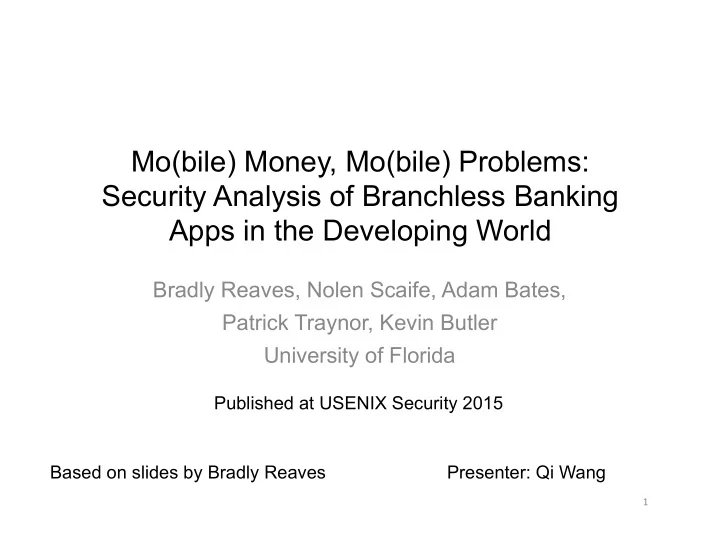

Mo(bile) Money, Mo(bile) Problems: Security Analysis of Branchless Banking Apps in the Developing World Bradly Reaves, Nolen Scaife, Adam Bates, Patrick Traynor, Kevin Butler University of Florida Published at USENIX Security 2015 Based on slides by Bradly Reaves Presenter: Qi Wang 1
Branchless Banking a.k.a Mobile Money • Generally deployed by companies outside of the traditional financial services sector • Their use does not require having a previously established relationship with a bank • They don’t rely on Internet connectivity exclusively, but also use SMS, Unstructured Supplementary Service Data or cellular voice to conduct transactions 2
Why this is important • Millions are relying on mobile money everyday, and even more will continue to do so – As of august 2014, there were 246 mobile services in 88 countries serving 203 million users • The security of mobile money has not been publicly investigated or verified 3
Analysis of mobile money apps • We did an automated analysis of 46 currently available mobile money apps • We did a manual analysis of 7 popular apps 4
Automated Analysis • We used the Mallodroid tool to analyze the TLS implementation of 46 mobile money apps for Android • Over 50% of apps had a SSL/TLS vulnerability 5
Manual Analysis: Apps GCash Phillipines Zuum Brazil MCoin Indonesia Money on Mobile India Mpay Thailand Airtel Money India Oxigen Wallet India About 1.2 million users 6
Manual analysis • Phase 1: Inspection • Phase 2: Reverse engineering • Security analysis of – Registration and login – User authentication after login – Money transfer 7
Findings: High level • 6 out of 7 apps had easily-exploited critical vulnerabilities • 28 Vulnerabilities in 6 of 7 analyzed apps • 13 CWE categories – SSL/TLS & Certificate verification – Non-standard cryptography – Access control – Information leakage 8
Vulnerabilities by App GCash 7 Money on Mobile 6 Oxigen Wallet 6 Mpay 4 MCoin 3 Airtel Money 2 Zuum 0 9
Vulnerabilities by type Number of Apps Number of Error Type Vulnerable Vulnerabilities TLS Certificate 4 4 Verification Non-standard 4 6 Cryptography Access Control 4 7 Information Leakage 5 12 10
TLS: Client side • Some apps overrode Android’s default certificate verification routines • Developers likely did this to silence certificate warnings during development or deployment • mCoin disabled validation routines for the application to function correctly – The server side provides a certificate issued to “localhost” which is expired and self-signed 11
TLS: Server side Qualys App Noteworthy Vulnerability Score GCash C Vulnerable to POODLE attack Money on Mobile N/A No TLS Oxigen Wallet F SSL 2 support, MD5 cipher suite SSL 2, Client-initiated Mpay F renegotiation, POODLE Attack Expired, self-signed certificate for MCoin N/A localhost Airtel Money A- Uses SHA-1 with RSA Zuum A- Uses SHA-1 with RSA 12
DIY cryptography: MoneyOnMobile All messages are sent over plaintext HTTP . 13
DIY cryptography: Airtel • This key is used to encrypt the user PIN, used to authenticate with the service • All of these fields are available in previous messages “protected” by broken TLS • Because TLS certificate validation is effectively disabled, we can get this account 14
Access control • Oxigen Wallet allows password reset with an unauthenticated SMS sent from a user’s phone • MoneyOnMobile only checked the PIN to move between screens in the app • mPay accepts and performs unauthenticated commands from its server • … 15
Information leakage • Logging – mPay logs include user credentials, personal identifiers, and card numbers – MoneyOnMobile logs include server responses and account balances • Preference storage – GCash stores the users’ PIN in the preference – mCoin stores the user’s name, birthday, and certain financial infromation. 16
Terms of Service • User is responsible for all authenticated transactions – When these systems are attacked, the user pays the price 17
Conclusion • Mobile money applications improve the standard of living for many in the developing world • However, significant vulnerabilities are identified in mobile money applications • Dramatic improvements to the security of mobile money applications are needed to protect these systems 18
Discussion • What’s the contribution of this paper? • Anyone has experience with mobile money? Is there any security flaw in the mobile money model? • What’s the reasons for the vulnerabilities in the apps? • Does regulations help improve finance security? • How to improve the security of mobile money systems? 19
Recommend
More recommend